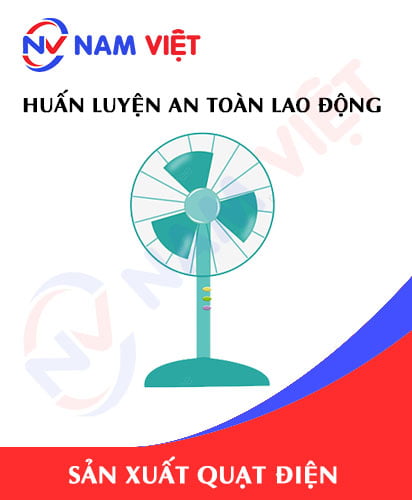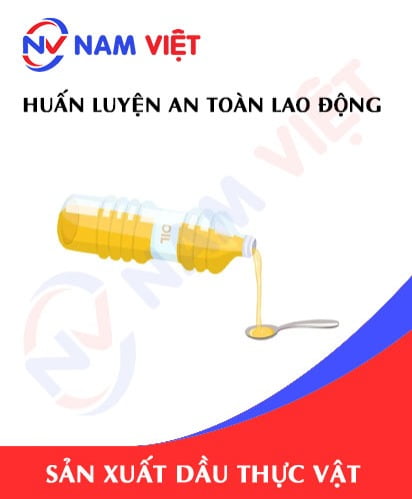Occupational Safety Training in Electric Fan Manufacturing Factory
99,000 ₫
Note: The above price is calculated for one person, the price may fluctuate depending on the number of trainees participating in the course and the movement of the market. For more accurate pricing support, please refer to the quotation table or contact our consulting staff directly.
Occupational safety is an important issue in electric fan manufacturing factories and needs to be addressed promptly to ensure the health and safety of workers and enhance the reputation of enterprises. The Occupational Safety Training course is one of the effective solutions to raise awareness about preventing occupational accidents for workers when participating in electric fan manufacturing.
Table of Contents
Toggle1. Overview of Electric Fans
a. What is an Electric Fan?
- An electric fan is a device used to create airflow to cool a space. It operates by using an electric motor to rotate the fan blades and push air through them, creating a breeze to cool the area. Electric fans can be used for household, office, industrial, agricultural, and other purposes.
- The electric fan manufacturing industry in Vietnam has seen significant growth in recent years. According to the 2020 Vietnam Electric Fan Market Research Report, the Vietnam electric fan market grew at a rate of 7.6% from 2015 to 2019 and is expected to continue growing in the following years.
- Electric fan factories in Vietnam are divided into two types: foreign-invested enterprises and domestic enterprises. Among them, foreign-invested enterprises account for a larger share compared to domestic enterprises.

b. Machinery Used in Electric Fan Manufacturing
There are various types of machinery and equipment used in the electric fan manufacturing process, depending on the production scale and technology applied. However, the following are some basic machinery and equipment commonly used in electric fan manufacturing:
- Metal Cutting Machine: Used to cut metal parts such as fan blades, fan housings, fan bases, etc.
- Metal Bending Machine: Used to bend metal parts into required shapes, such as bending fan blades.
- Metal Punching Machine: Used to punch holes in metal parts, for example, to assemble fan components.
- Metal Welding Machine: Used to weld metal parts together.
- Plastic Injection Machine: Used to mold plastic parts of electric fans.
- Plastic Cutting Machine: Used to cut plastic parts such as fan housings and bases.
- Printing Machine: Used to print labels, logos, or images on fan components.
- Inspection and Testing Equipment: Used to check product quality and test the performance of fan components.
Other equipment such as drills, grinders, surface grinders, milling machines, balancing machines, etc., are also used in electric fan manufacturing.

c. Typical Electric Fan Factories in Vietnam
In Vietnam, there are many factories producing electric fans under different brands, among which some typical factories are:
- AC Fan Joint Stock Company (AC Fan): one of the pioneering factories in electric fan manufacturing in Vietnam, established in 1992. AC Fan is a well-known electric fan brand in Vietnam with a wide range of high-quality products in various designs, sizes, and functions.
- Etech VN Co., Ltd. (Vietnam Electrical Technology and Equipment): a leading enterprise producing and supplying high-quality electric fans, including wall-mounted fans, ceiling fans, standing fans, box fans, industrial fans, and mini fans.
- Phu Gia Manufacturing and Trading Co., Ltd.: a leading electric fan factory in Vietnam, specializing in ceiling fans, standing fans, pedestal fans, and box fans with high quality and diverse designs, colors, and functionalities.
- Minh Ha Fan Co., Ltd.: a major electric fan manufacturer in Vietnam with many years of experience, specializing in industrial fans, ceiling fans, wall-mounted fans, standing fans, box fans, and pedestal fans in various designs, sizes, and functions.
- Tien Phong Fan Co., Ltd.: a reputable electric fan manufacturer in Vietnam with many years of experience in producing and supplying electric fan products.
d. Specific Jobs in an Electric Fan Factory
Group 1
- CEO, deputy CEO, department heads in the electric fan factory.
Group 2
- Safety Officers: manage safety in the factory, design safety procedures, supervise, and enforce employee compliance with safe work processes.
Group 3
- Purchasing Raw Materials: This work is done by purchasing staff who contact suppliers to order necessary components for electric fan manufacturing.
- Metal Processing: Metal components of the fans are processed using equipment such as cutting machines, bending machines, punching machines, welding machines, etc.
- Plastic Processing: Plastic components are processed using machinery such as injection molding machines, plastic cutters, etc.
- Product Assembly: Processed parts are assembled to form finished electric fans. This work is carried out by factory workers.
- Product Inspection and Testing: Assembled products are inspected and tested to ensure quality and performance meet technical requirements.
- Packing and Shipping: After inspection and testing, products are packed and prepared for delivery to customers.
Group 4
- Office, support, sales, and marketing work.
- Production management, quality management, human resources management, material management, financial and accounting management.
- Product Design: Conducted by engineers and design staff who create technical drawings, analyze, and calculate to design fan components.

e. Common Types of Electric Fans
There are many common types of electric fans on the market, including:
- Ceiling Fan: Installed on the ceiling to circulate air in living rooms, bedrooms, kitchens, restaurants, hotels, etc.
- Evaporative Fan: Cools by using water and air, commonly used in restaurants, gyms, factories, etc.
- Pedestal Fan: Portable and easy to use, helps cool living rooms, bedrooms, offices, etc.
- Cabinet Fan: Compact and space-saving, often used in small spaces like offices to ventilate and reduce heat.
- Air Conditioning Fan: Combines cooling function with air conditioning system to regulate room air, widely used in living rooms, bedrooms, offices, and shops.
- Computer Fan: Small-sized fan used to cool computers and electronic devices.
- Industrial Fan: High-capacity fan used in factories, warehouses, industrial parks, and farms to ventilate and cool machinery and staff.
2. Overview of Occupational Safety Training for Electric Fan Manufacturing
In this article, we focus on Group 3 because Group 3 directly participates in the manufacturing process and faces the highest occupational safety risks. Refer to other groups here
a. What is Group 3 Occupational Safety Training?
- Group 3 Occupational Safety Training consists of lessons that equip workers with awareness on how to prevent workplace accidents.
- The training course helps workers identify and avoid hazards, reducing the risk of accidents during work.
REGISTER FOR OCCUPATIONAL SAFETY TRAINING SERVICE
b. Training Duration
Initial Safety Training
- Total training duration is at least 24 hours, including testing time.
- 8 hours of theory on safety and labor hygiene policies and laws
- 8 hours of theory on basic safety and labor hygiene knowledge
- 4 hours of theory on specialized training content
- 2 hours of practice on specialized training content
- 2 hours of final theoretical test
The safety training center schedules the sessions depending on worker availability. Usually, there are 6 sessions, completed over 3 days if the factory can allocate continuous training time.
Periodic Safety Training
- Before the occupational safety card expires, workers seeking renewal must undergo periodic safety training, with training duration of at least 50% of the initial safety training duration.
Explanation: total periodic safety training time is at least 12 hours, including testing. After completing the course and passing the test, workers will receive a renewed occupational safety card.
c. Training Content
| No. | TRAINING CONTENT | TRAINING DURATION (HOURS) | |||
| Total | Including | ||||
| Theory | Practice | Test | |||
| I | Safety and labor hygiene policies and laws system | 8 | 8 | 0 | 0 |
| 1 | Overview of legal documents related to occupational safety and labor hygiene. | 6 | 6 | ||
| 2 | System of standards and technical regulations on occupational safety and hygiene. | 1 | 1 | ||
| 3 | Specific regulations by state authorities on safety and hygiene when constructing, expanding, or renovating factories, facilities, or machinery that require strict safety and hygiene compliance. | 1 | 1 | ||
| II | Basic knowledge of occupational safety and hygiene | 8 | 8 | 0 | 0 |
| 1 | Basic knowledge of workplace hazards and risks. | 4 | 4 | ||
| 2 | Methods to improve working conditions. | 1 | 1 | ||
| 3 | Safety culture in manufacturing and business operations. | 1 | 1 | ||
| 4 | Rights and responsibilities of employers and workers; policies on occupational safety and hygiene; roles and duties of safety officers. | 1 | 1 | ||
| 5 | Occupational safety rules, signage, use of safety equipment, personal protective equipment; first aid skills, occupational disease prevention. | 1 | 1 | ||
| III | Specialized training content | 6 | 4 | 2 | 0 |
| Comprehensive knowledge of machinery, equipment, hazardous substances; risk analysis, occupational safety and hygiene management, safe work procedures with machinery, equipment, and hazardous substances. | 6 | 4 | 2 | ||
| IV | Final safety training test | 2 | 2 | 0 | 0 |
| Total | 24 | 22 | 2 | ||
See more training content of 6 groups
d. Occupational Safety Card
After completing the occupational safety training and passing the test, workers will be issued a Group 3 Occupational Safety Card (commonly called Group 3 Occupational Safety Certificate).
The Group 3 safety card displays personal information such as name, date of birth, specific job and working environment, along with training duration, red stamp, and signature confirming training completion.
According to Clause 2 of Article 24 of Decree 44/2016/ND-CP, there are two cases:
- If the employer and worker have a labor contract, the employer must sign, stamp, and certify the Group 3 safety card after the worker completes training at an occupational safety training unit and passes the test.
- If the worker is freelance or seasonal, without a labor contract, the training unit must sign, stamp, and certify the safety card after the worker completes training and passes the test.

3. Identifying Hazards Affecting Workers During Electric Fan Manufacturing
During the process of electric fan manufacturing, there are several hazards that can affect the health and safety of workers. Below are some common hazards and how to identify them:
- During electric fan manufacturing, workers are exposed to high-voltage electricity, which can be dangerous to their health and life. Risks include electric shock, fire, explosion, etc. To reduce this risk, employees need to be trained and apply electrical safety measures.
- During electric fan manufacturing, workers need to operate machinery such as metal cutting machines, plastic pressing machines, etc. If personal protective equipment is not worn properly, workers may suffer injuries or even death due to workplace accidents.
- During electric fan manufacturing, workers handle materials and chemicals such as metals, plastics, solvents, etc. These materials and chemicals can cause skin irritation, respiratory toxicity, etc. If protective equipment and safety measures are not properly used, workers’ health may be affected.
- During electric fan manufacturing, workers can be exposed to noise from machinery. High noise levels can damage their hearing and affect mental health. Workers need to wear ear protection and use noise reduction equipment to minimize this risk.
4. Common Workplace Accidents in Electric Fan Manufacturing
Common workplace accidents during electric fan manufacturing include:
- Puncture, cut, and injuries from machinery: This is one of the most common accidents in electric fan manufacturing. Workers may be punctured, cut, or injured by machinery such as metal cutting machines, plastic pressing machines, etc. Without proper personal protective equipment, workers may suffer injuries or even death.
- Electrical accidents: Workers in the electric fan factory may be exposed to high voltage, electric shocks, or explosions. Without proper training and application of electrical safety measures, workers can face serious risks to life and health.
- Chemical poisoning: Workers may also be affected by chemicals such as solvents, paints, and cleaning agents. If protective equipment and safety measures are not properly used, workers may experience skin inflammation, itching, difficulty breathing, headaches, nausea, or severe chemical poisoning.
- Falling material accidents: Workers may be injured by falling materials from height or machinery. These materials may include fan parts, metal materials, etc.
- Accidents from improper use of protective equipment: Workers may be injured or poisoned if protective equipment such as gas masks, gloves, safety glasses, and safety shoes are not used properly.

5. Safety Measures When Participating in Electric Fan Manufacturing
To ensure the safety of workers during electric fan manufacturing, safety measures need to be applied. The following are some safety measures to be implemented:
- Wear full and proper personal protective equipment, including helmets, safety glasses, gloves, safety shoes, masks, etc.
- Provide comprehensive and proper training for workers on occupational safety and electric fan manufacturing procedures.
- Ensure machinery in the electric fan factory is regularly maintained and inspected to ensure safe operation.
- Properly use protective equipment such as gas masks, gloves, safety glasses, and safety shoes.
- Control temperature, humidity, and noise in the electric fan factory to ensure a safe working environment for workers.
- Control electrical sources, electrical equipment, insulation, grounding, and protection to prevent electrical accidents.
- Handle chemicals and solvents safely during electric fan manufacturing and comply with environmental protection regulations.
- Operate machinery according to proper procedures and safety instructions.
- Conduct regular safety inspections of machinery, electrical systems, and factory structures to ensure worker safety.
- Ensure safety barriers and other safety measures are properly implemented to minimize accident risks for workers.
- Periodically perform occupational environment monitoring in the factory, collect and analyze harmful factors, and adjust to reduce hazards to prevent occupational diseases.
6. Benefits of Occupational Safety Training in Electric Fan Manufacturing
An Toan Nam Viet provides your company with the following benefits after completing occupational safety training courses according to Decree 44/2016/NĐ – CP on occupational safety and hygiene for companies and factories:
- Workers can recognize potential workplace hazards and take preventive measures to avoid accidents.
- Your company can establish risk prevention measures in manufacturing, operation, and maintenance processes.
- Reduce costs associated with workplace safety risks.
- Continuous production increases labor productivity and product quality.
- Compliance with labor safety laws to avoid legal risks.
- Enhances reputation and professionalism, improving your company’s brand value.
Nam Viet’s training courses help individuals prevent external hazards that may lead to injuries or worse, death.
REGISTER FOR OCCUPATIONAL SAFETY TRAINING SERVICE
7. Customer Feedback After Completing Electric Fan Manufacturing Safety Training
An Toan Nam Viet has years of experience accompanying many businesses across Vietnam, especially in southern provinces. This responsibility is invaluable, which is why Nam Viet’s Occupational Safety Training is increasingly professional. The motivation for Nam Viet’s growth comes from positive feedback and suggestions from our corporate clients. Below are some testimonials from our partners.
See more customer interviews after using services from An Toan Nam Viet
8. Occupational Safety Training Capacity of An Toan Nam Viet
An Toan Nam Viet is a reputable and quality occupational safety training center in Vietnam. Safety training courses are continuously conducted at factories, workshops, or construction sites nationwide (63 provinces).
REGISTER FOR OCCUPATIONAL SAFETY TRAINING SERVICE
Occupational Safety Training License
- An Toan Nam Viet has been inspected and certified by the Department of Labor Safety under the Ministry of Labor, Invalids and Social Affairs, confirming our capacity to operate occupational safety training.

Materials and Lectures
- Before being included in occupational safety training courses, materials are reviewed to ensure accuracy and effectiveness.
- Teaching methods follow the standard of An Toan Nam Viet, developed by occupational safety experts to maximize knowledge absorption for learners.
Facilities
- Controlling classroom factors enhances teaching performance and learning efficiency.
- Our training facilities are spacious, meeting standards for area, lighting, and training equipment.
9. Nationwide Reputable Occupational Safety Training Center
At An Toan Nam Viet, we prioritize professional occupational safety training. We ensure every detail, from tools and equipment to curriculum, materials, sound, and lighting, is carefully prepared.
Our instructors are experts with extensive experience and research on identifying hazards in all industries and how to prevent them. Lectures are practical and engaging, ensuring learners can easily understand and apply knowledge. All content aligns with Decree 44/2016/NĐ-CP.
Our training center is proud to provide professional occupational safety training services with advantages such as:
- Competitive training costs with quality assurance.
- Flexible training schedules according to company manufacturing needs.
- Quick certification procedures in compliance with the law.
- Experienced instructors.
- Classrooms controlled to optimize teaching performance and knowledge absorption.
- Lectures tailored for occupational safety in companies.
- Dedicated and professional support for clients.

10. Additional References for Occupational Safety Training in Electric Fan Manufacturing
- Occupational Safety Materials for Electric Fan Manufacturing
- Occupational Safety Training Materials Set
- Occupational Safety Training Test Set
- Electric Fan Manufacturing Occupational Safety Multiple-Choice Test
- Slides for Occupational Safety Training in Electric Fan Manufacturing
1 review for Occupational Safety Training in Electric Fan Manufacturing Factory
No comments yet















namchinh.haiphong341
Hài lòng nhé!